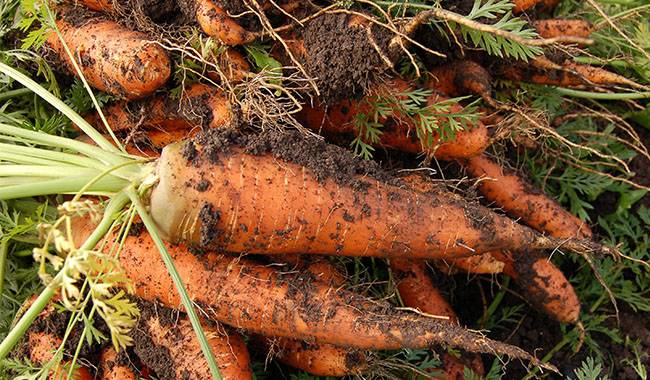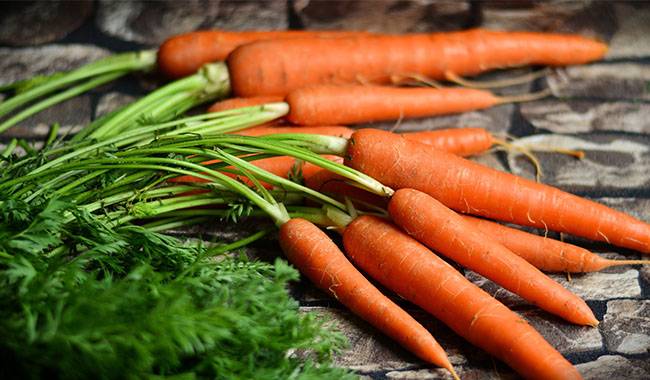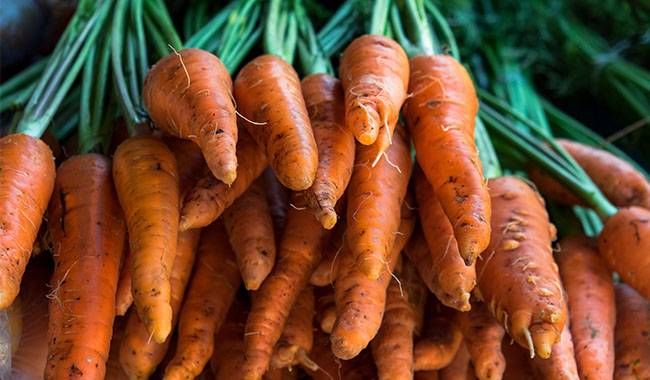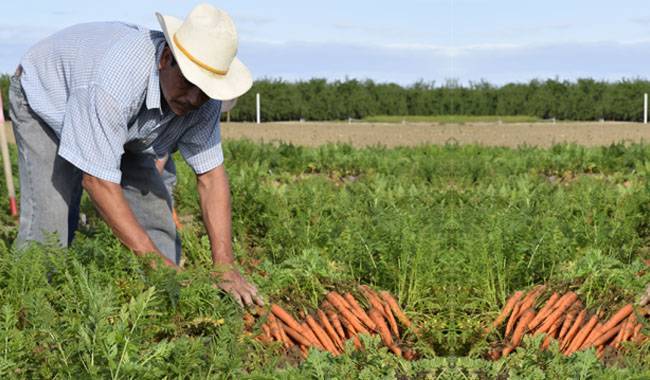
That question, or rather the two questions that plague many gardeners. When to start digging table beets and when to start removing carrots from raised beds? No one wants to be in a hurry, but no one wants to be late either.
In fact, the right and most appropriate harvest date for these simple root crops depends a lot on the flavor of the root crops, and their quality and vitamin content for processing and consumption.
If you dig them early, they (the vitamins) will not have time to accumulate in them and, of course, the storage time of the root crops will be reduced. Indeed, harvest carrots & beets too early or too late and you will rot the roots in the wintertime, which is mediocre to lose the crop.
A lot depends on the simple inscription on the seed package. In black and white it is written how many days should elapse between the appearance of the first shoots and the digging out of the root crop. Of course, nature itself interferes here: after all, the summer can be hot and well-watered, and then the dates on the package may match up fairly precisely. Or it could be cool and deprived of extra moisture in the form of rain, and then the root crops will ripen later and, accordingly, need to be dug up later.
Let’s take our time with everything and then, I’m just sure that at the end of the material, you have a clear idea of when to dig out and carrots, and beets on the table.
WHEN TO HARVEST CARROTS AND BEETS?
Carrots and beets are cultivated in roughly the same way, with no particular conclusion. But at the end of the day, the vast majority of gardeners tend to one opinion – dig out carrots after the first frost, and beets – be sure to exclude the smallest, otherwise, they will not lie down exactly.
Generally speaking, there is certainly a grain of truth in this. As for carrots, they can tolerate frost and can be dug up even after the first autumn snow without freezing. However, in order to prevent carrots from freezing for sure, you should use a little trick: walk around the garden and press the carrots into the soil. This method can’t exactly be called new, but it allows carrots to go through all the stages of storage preparation. It has long been noted and has been proven more than once, that if you dig up your carrots before the frost, the storage volume will be 30% less than if you dig them up.
As for eating beet, as we have already mentioned, everyone agrees that by the first frost, beet should at least have been pulled out of the soil. Although, on the other hand, if there is normal autumn and dry weather, without rain, the edible beet in the soil feels quite good: in the soil, it will be preserved better than if it was dug in advance in the cellar or basement. And the rottenness of beets in the future will be at least 50% higher.
When it rains in the fall it is a different matter. There is an extremely high probability here that the root crops collect so much unnecessary moisture that they begin to spoil during storage. Obviously, if you delay digging up edible beets during the wet season, they will be completely unsuitable for storage. This is partly the right thing to do for gardeners who don’t take the risk of waiting to add a few grams for nothing, but instead dig up beets as soon as the first frost threatens, or as soon as the cold falls rains start to pour in.
The timing of digging up carrots and beets may depend entirely on the growing region. Thus, if you are a resident of the southern region, digging will take place later, the central region – in the middle, and the northern region – at the earliest. You should also be guided by the forecast for the beet-growing region: therefore, what to do if the meteorologist predicts a severe frost? And about the time of maturity of the variety should be taken into account.

HARVEST CARROTS
Yellowing of the lower and middle leaves may be a sign to dig out your carrots. There is no time to waste, you can just take the root crop out of the ground and inspect it carefully. If it has tiny white stalks, then it’s ready to be picked. If the root crop has cracks, then the entire crop should be dug up as soon as possible because the carrots have grown too big. As for the time to harvest, the best time is the second half of September, near October.
Once you have decided on the time, you can start digging carrots. To do this, it is best to choose a sunny day, with a few days without water, of course, and the soil should be dry on the day of digging. Digging out carrots with a pitchfork is easy: not only is it easy, but carrots can cause as little damage as possible.
Digging can be done in pairs: one person picks the carrot with a pitchfork and gently pulls it to the surface while the other pulls it out of the ground with the tip. Then using your hands, not a knife or anything else, you can try to scrape the dirt off the carrot and place it on the soil of root crops of equal length, or put those that will go into seed production for the next year for stored food consumption.
After digging, inspect the root crops: those that show signs of damage should be immediately put into processing or consumed fresh, and those that are intact and fully developed should be sent to storage or in a separate box for planting (as seeds).
A word about the suggestion to dry carrots directly on a raised bed. In my opinion, you should cut off most of the traction at once, leaving shoots about 1 inch long at most, or better yet, remove them completely and let the root crop dry for a few hours (otherwise the traction will pull moisture away from the roots). Next, we send the carrot to a dark place for five or six hours where it will cool and finally be ready for storage.
Once dug, the description of the order in which the carrots should be stored continues. There are actually many options here. Naturally, the best place to store carrots is in a cellar or basement, where the temperature is exactly 39°F (4°C) and the humidity is 80%. On the balcony, for example, in a bag, long-term storage of carrots does not work, it simply begins to rot there. And if there is no glass on the balcony and no heating, it will freeze to death.
A good option – is the cellar, which is built with shelves, treated with 2% copper sulfate, and they pile the boxes and carrots together, sprinkled with dry and clean sawdust. Instead of sawdust, dry and clean river sand can be used, quite a suitable option (only the gap in the crates should be minimal so that the sand does not overflow).
In some cases, root carrots are still stored on the glass on the balcony, but not heated. First, soak them in a clay mixture and let it dry so that the carrots can safely lie throughout the winter if it is not very cold.
In a room with low humidity, simply a dry room, carrots can be placed in ordinary bags, but ventilated, with holes punched in the bags beforehand and sawdust interspersed in the roots of the carrots.
In the basement, the carrots are stored and an area is allocated under it, usually enclosed with fresh, clean boards. Dry and fresh planks should also be laid on the floor and mugwort, for example, placed on top in a 1.2-1.6inch (3-4cm) layer. Mugwort keeps mice away and they don’t touch it in winter.
If there are no storable cabinets, carrots can also be stored in the basement, but in a fresh wooden box, sprinkled with sawdust and covered with polyethylene film so that the excess moisture does not evaporate, as it is usually warm in the basement.
HARVEST BEETS
Digging is best done before the temperature drops to 32°F (0°C) and before the heavy rain season. As for the calendar period, it is usually in mid-September and lasts until mid-October. Dig edible beetroots on sunny days when the soil is dry and there is no excess moisture.
In any case, do not dig beets before the specified period. The problem is that from about the end of August to the beginning of September, the beet pulp accumulates the maximum amount of sugar and other important and useful elements.
The sign of digging up beets is usually small bumps, which are clearly visible if you look closely. The bumps are on the very surface of the root crop (a sign that it is time to dig them up).
Also, of course, you need to pay attention to the weather forecast and pay attention to the leaf discs: on the leaf discs, as in root crops, there are nodules – a clear sign that the beetroot is ripe. You should also pick up a vegetable and check it from all sides so that it is also easy to know whether the beetroot is ripe or not.
The best time (as we briefly noted above) is autumn when the temperature is right and the soil is dry, and this is the weather for digging beets.
In my opinion, it is easier to dig up edible beets with a pitchfork: this causes less damage to the root crop. After digging remove the traction from the roots to prevent it from drying out, leaving only a 0.4inch (1cm) long stump (do not tear the traction with your hands, as this will damage the roots), and then spread the rhizome in the sun for a few hours.
Important note: table beetroots to be stored should never be washed. Instead, treat them as you would carrots, examining each one carefully, leaving only those undamaged and at least seemingly perfectly healthy for storage.
So, take the beets that you have sorted and carefully cleaned from the soil, using gloves instead of a spatula, and lay them in any dry room where there is good ventilation and no direct sunlight that would fall on the beets. In such a room, the beets should be left for 6-7 days so that the rhizomes will be completely dry and ready for storage. Thereafter, beetroots can be safely transferred to any storage facility for overwintering.
Storing beets can also be done, as with carrots, in a basement or cellar, preferably at a temperature of 32-35°F (0-2°C) and 90% humidity. If the weather gets warm, root crops will quickly begin to wilt, develop rot and other diseases, and in general, lose the harvest. Table beet is particularly sensitive to heat in the early stages of storage, then even at 39°F (4°C) it will start to grow traction, and after about a month you should leave it at about 34°F (1°C) and no more.
Be sure to also keep the air circulation in the storage room, this also applies to the storage of carrots and beets. Ideally, the ventilation should be natural and the backyard where the beets are stored should be above ground level, at least 2-4inch (5-10cm) so that air can pass through there as well. Such an easy method will allow constant cooling of root crops without making them sweat and without contributing to the formation of rot and other problems.







